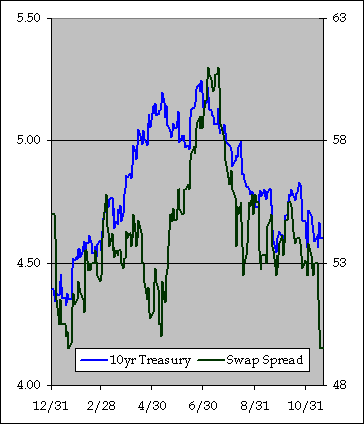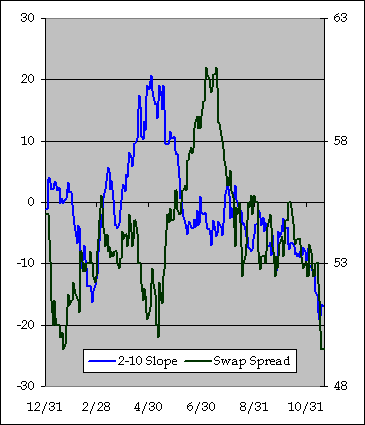If you were focused on the rate gyrations from last week, you might have missed what was actually the most important move in investment grade fixed income. Swap spreads. For our more casual readers, swap spreads represent the difference between the Treasury rate and the rate on the fixed portion of an interest rate swap. So for example, if one wanted to enter into a 10-year interest rate swap today, where you would be paying a fixed rate over the 10-years and receive 3-month LIBOR, the fixed rate would currently be 5.10%. That is currently 50bps over the 10-year. So we would say the 10-year swap spread is 50bps. Swaps are available for pretty much any term you like. Swap spreads tend to be about the same as very strong corporate spreads. On the short end, the corporate spread might be a little tighter and on the long end the swap spread is a little tighter.
This is extremely important for determining spreads of other products, in large part because swaps are a common means of hedging a fixed rate position. So if you are a corporate trader looking to take on credit risk, but want to eliminate interest rate risk, you would use a swap to do it. And if the swap spread rises, then your desire to own the hedged credit position diminishes, causing credit spreads to widen. MBS and Agency debt is also highly swap correlated.
The 10-year swap spread moved 4.5bps tighter in the last week, which might not sound like much, but is actually quite a move. 4.5 bps is about 3/8 of a point on the 10-year. The graph below shows it a little more dramatically.
The swap rate (green) moves down suddenly right at the end. There are a couple broad reasons why swap spreads tend to move. One is the slope of the curve, because a steeper slope allows for more carry trades, which increases the demand for rate hedges. But as the second graph shows, the curve has moved a good bit flatter (more inverted) during this period. 
In fact, look back to June, when swap spreads were their widest. The slope has moved consistently flatter/more inverted, but swap spreads keep tightening. So that does not explain it.
Sometimes when the Treasury market sees a big rally, the swaps market lags. From 11/10 to 11/17, the 10-year was 1bps higher in yield. So that isn't it either.
Volatility can move swap spreads, with lower vol implying tighter spreads, but vol isn't moving. The implied vol on 5x5 swaptions was virtually unchanged last week. Vol has climbed from 15.3 in June to 16.8 now. All that time, swap spreads have gotten tighter.
To me, there is only one good explanation. Cash. Cash coming from the sidelines into the market and not enough supply to take it. Think about it: we know that MBS issuance is way down this year due to housing activity and higher rates. We also know that corporate issuance has been lackluster for a couple years. Even Agency issuance has been down due to delevering on the GSE's part. Meanwhile everyone from PM's to CDO managers to foreigners have to put cash someplace.
Monday, November 20, 2006
An even swap
Subscribe to:
Post Comments (Atom)



2 comments:
Tom, unless cash is in physical currency, it is never "sitting on the sidelines." It is always invested by someone.
Your bank account balance is being used as a tiny bit of the collateral for someone's home loan.
Your money market fund holdings are invested in short-term government and commercial paper. The government and corporations are using that money to fund operations, buy stuff, etc.
Welcome to the blog. Nice to have new comments.
You are right from a macro perspective, obviously. But if we assume the long-term demand for money markets is constant (maybe excluding some seasonality), then any time MM balances rise, that cash winds up getting invested in long-term securities eventually.
Since standard cash rates, like LIBOR, are indirectly controlled by central banks, high money market balances tend not to move short-term rates. But if typical buyers of long-term securities are not buying, then that will cause long-term rates (or spreads) to increase, all else being equal.
Post a Comment